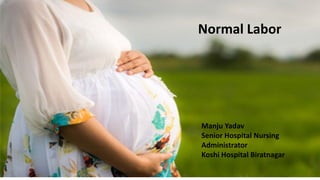This document provides information about normal labor, including:
- The definition of normal labor and its stages. Normal labor has 3 stages and may last 12 hours for a primigravida.
- The signs and symptoms of each stage of labor. The first stage involves cervical dilation from 0-10cm. The second stage involves fetal expulsion.
- The physiological changes that occur in the first stage, including uterine contraction, cervical effacement and dilation.
- The factors that can influence the duration of normal labor, including primigravida/multipara status, pelvis size, and fetal size and position.































































